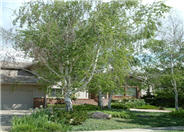
Common name:White Birch, European White Birch
Botanical name:Betula pendula
This medium-size weeping tree will grow to about 40' tall and has a whitish/brown bark with deciduous green leaves.
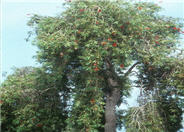
Common name:Weeping Bottlebrush
Botanical name:Callistemon viminalis
The Weeping Bottlebrush is a small tree with spreading branches that grows to 15'-25' in height. It produces narrow clusters of dark red flowers, and performs best with average to occasional summer watering.
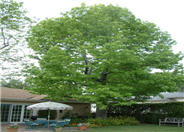
Common name:Liquidambar, American Sweet Gum
Botanical name:Liquidambar styraciflua
A tall, deciduous tree of upright, pyramidal habit, the liquidamber has dark green, maple-like leaves that turn beautiful shades of red and yellow in the fall season. It can be used as a single specimen, hedge, or grouped plant.
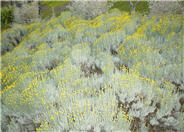
Common name:Gray Lavender Cotton
Botanical name:Santolina chamaecyparissus
This ground cover/small shrub will grow to 3' tall and has small, grayish silver leaves with yellow flowers that bloom in the summer.
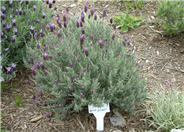
Common name:Otto Quast Spanish Lavender
Botanical name:Lavandula stoechas 'Otto Quast'
This round shrub will grow to about 3' high and has small, gray green leaves with purple flowers that bloom in summer. It is more prostrate than its parent Lavandula stoechas. The flowers resemble a purple pineapple! 'Otto Quast' is drought tolerant once it is established and cold tolerant to 5 degrees F.
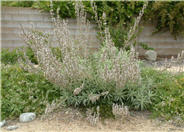
Common name:White Sage, Sacred White Sage
Botanical name:Salvia apiana
This woody shrub has long stems with silvery white leaves and fragrant white flowers that bloom in the spring. It provides a strong structural form as a garden focal point. It can reach 6' tall and 6' wide.
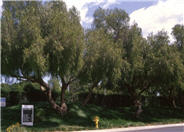
Common name:California Pepper, Mission Pepper
Botanical name:Schinus molle
The California Pepper is a fast growing evergreen tree that will mature to a height of 25'-40' and as wide. Its bright green leaves are divided into many narrow, 1.5"-2" long leaflets.
| Designer: Gwen Romani | Feral Garden |
Photographer: GardenSoft |
Soils and Compost:
Practice grass-cycling by leaving short grass clippings on lawns after mowing, so that nutrients and organic matter are returned to the soil.
Water Saving Tip:
Apply a layer of mulch around plants to reduce moisture loss.
Choose organic mulches, such as shredded bark, compost or aged sawdust.
Integrated Pest Management:
Remove irrigation water and fertilizer from areas where you don't want weeds to grow.
